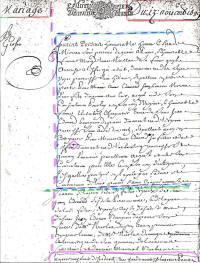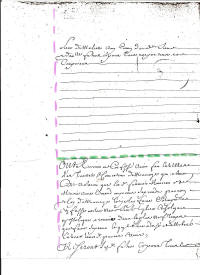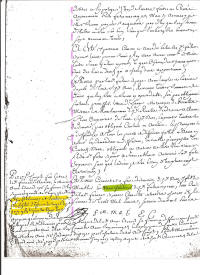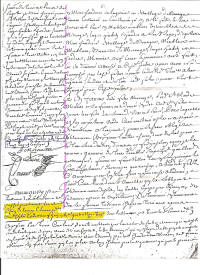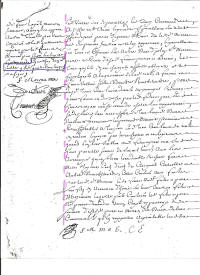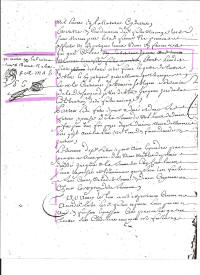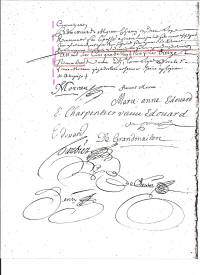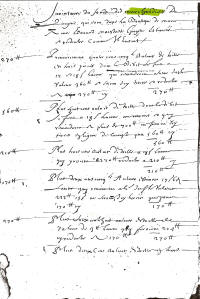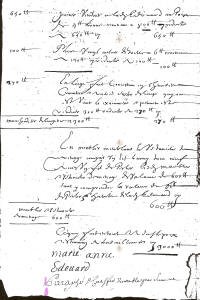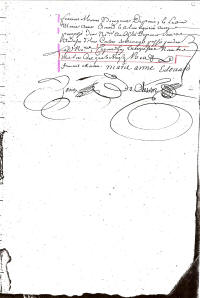 The
Ranums'
The
Ranums'
Panat Times
Volume 1, redone Dec. 2014
The Wedding Contract as a Creative Process
The format of a typical notarial contract, and some parallels that can be drawn with the format of Marc-Antoine Charpentier's autograph manuscripts
In the paper I presented at the Charpentier conference at Versailles in the fall of 2004, I proposed that analogies can be drawn between the practices of French notaries and the scribal practices observed by Marc-Antoine Charpentier when compiling the Mélanges, that is, his working archives. (The paper has since appeared: "Marc-Antoine Charpentier 'garde-nottes,' ou les Mélanges comme travail de scribe," in Les Manuscrits autographes de Marc-Antoine Charpentier, ed. Catherine Cessac, C.M.B.V. and Éditions Mardaga: Wavre, 2007)
I argued that each piece in Charpentier's Mélanges resembles a minute (that is, a signed and filed copy) of a transaction or a decision preserved in the files of notaries and law clerks. I also proposed that this should scarcely surprise us, because the composer was the son of a maître écrivain, a master calligrapher and scribe, and he clearly had been brought along to help in the family business.
This broad assertion about Charpentier's familiarity with the scribe's craft applies to the scores in the Mélanges that the composer seems not to have tampered with during the three decades of his professional activities; but it likewise applies to the scores that he subsequently modified. That is to say, the former are shaped according to the practices of his father's craft, and the modifications made to the latter are shaped by those same practices. Indeed, I am convinced that seventeenth-century notarial and scribal practices can shed light on the more problematic pieces to which Charpentier added marginalia, specified the names of performers, and modified or added to a piece.
While the Centre de Musique Baroque de Versailles was producing the volume, I received a few queries related to my paper. One query was about theatrical music: it came from John Powell, who was trying to decide what considerations, during the compositional process, probably date from almost the moment Charpentier was offered a commission; what details or emendations might conceivably have been added as a result of rehearsals; what details could have been added once the show had closed and the composer was putting the notebook away into his personal archives; and what details may well have been added years later.
John Powell's questions showed me that I really must put our site to good use and expand upon the parallel between scribal practice and Charpentier's manuscripts, which I could only present superficially in my article on Charpentier "garde-nottes." Indeed, scholars who have never worked with notarial documents might benefit from having a notarial act dissected for them. What follows is a simplified "anatomical" sketch of a typical notarial act specifically, the notary's copy, minute, of the wedding contract he drew up prior to the marriage of Marc-Antoine's niece, Marie-Anne Édouard in 1689.
I first marked in color the most revealing segments of the wedding contract (preserved in the Archives nationales of Paris, Minutier central des notaires, VI, 590, "Mariage, du 13 novembre 1689"). Unfortunately, the French paper was too long for my photocopier, so that part of an emendation (apostille) was cut from the bottom of the first page, and the papier timbré stamp across the top of some pages was eliminated. I will comment upon each element in turn. [To suggest the relationship between the scribal practices of the notary who drew up the minute and Charpentier's scribal practices in the Mélanges, in a different type face, and within square brackets, I will also insert a few references to my article on Charpentier as a "garde-nottes."]
page 1:
page 2:
page 3:
page 4:
page 5:
page 6:
page 7:
Before drawing up the marriage contract, Notary De Clersin consulted the families and took notes on the amount of the dowry, the préciput, the douaire, etc, that each spouse would receive. He and the families also worked out specific arrangements about property going to the couple, or about who would be responsible for debts. These notes were, of course, discarded once the contract had been drawn up. [This rough draft amounts to the preliminary canevas that Charpentier presumably made when he set about writing a piece, and that he discarded as the work progressed.]
In the calm of his workroom, the notary drew up the minute of the contract that is, a clean copy that he and the participants would sign and that he would keep in his files. The contract took the form of a notebook, cahier. Since Marie-Anne had few possessions, the cahier was thin, two folded sheet of paper.The outer sheet forms pages 1-2 and 7-8 (page 8 is not shown because it is blank), and the inner sheet forms pages 3-4 and 5-6. [Marc-Antoine Charpentier folded papers in this same way, to make the different cahiers of the Mélanges. Incidentally unless the rag paper was of a very high quality and therefore very thin, it was difficult to fold more than eight superimposed sheets.] Any corrections made to this minute on the day of the signing would be initialed by the notary and his clients. Known as apostilles; these changes are generally found in the wide margin the left of the dashed vertical line that I have marked on most pages of the contract. [This wide left margin, into which information can be added, is standard in Marc-Antoine Charpentier's manuscripts, pp. 32-33, Ranum.]
Although notaries frequently used a little sign to show exactly where the modification belonged in the text, for the apostille on page 6 Maître De Clersin simply crossed out the better part of two lines, wrote the revised version in the margin, and asked the bride and groom to initial the change. However, on page 1 he added a few words about the bride at the bottom of the page and inserted a cross in front of it, and another cross after the word "deffunt" (her deceased father) in the text proper, to show exactly where the apostille belongs. [When he inadvertently omitted a measure, Marc-Antoine Charpentier used similar little "insert" marks, Ranum, pp. 34-35.] These corrections would not be seen in the presentation copy made later for the bride and groom, because they were, so to speak, repaired during the recopying process.
The broad left-hand margin, and the tendency to carry every line all the way to the right edge of the paper was but one element that shaped the appearance of a notarial contract. Whoever the notary might be, the documents he drew up were based on very predictable formularies:
An act began with an introduction known as the intitulé (it is marked off by blue lines on page 1). This paragraph named the parties involved in the act in this case, the bride and groom and their parents. It also provided their addresses and occupations.
In the case of a wedding contract, next came the list of relatives and assembled friends who have witnessed the signing, (the list is marked off by horizontal green dashes on pages 1 and 2). Since the notary did not know who would be present, or how many signatories there would be, he usually left about 4 inches blank. [When finishing a composition, was Marc-Antoine Charpentier always sure who the specific performers would be, and exactly how many would sing in the chorus? Indeed, at what moment did he mark a performer's name in the left-hand margin?]
Then came information about the dowry etc., followed by other specific financial arrangements. In this particular contract, the contractual details continue for some five pages (pages 2-6). One of the clauses involved the making of a detailed list of the merchandise (page 3) in the bride's shop. The inventory has survived, as a four-page cahier (pages A. B, and C; page D is not shown because it is blank.) The inventory was drawn up by a different scribe, and on slightly smaller sheets of paper. [Marc-Antoine Charpentier did not always use a given brand of paper from start to finish of a composition, nor were the dimensions of the sheet and the staves in a given cahier always consistent.]
NOTE: You can click the "thumbnails" to read the inventory. Note also, on pages B and C, the string that pierces the fold at mid-page: Charpentier's own cahiers may have been held together in that way.
page A
page B
page C
On that November day in 1689 when the wedding contract was signed, Maître De Clersin and the couple signed both the contract and the inventory (the red boxes on page 7 and page C of the inventory). In other words, despite its different appearance, the inventory was an integral part of the prenuptial agreement. It was not a later addition.
That day, the contract was read aloud, so that everyone present would be fully informed of all the details in the agreement. When Maître De Clersin finished, the young couple and all their "relatives and friends" signed the contract (page 7). The bride and groom usually signed first, along with their parents; next came their close relatives; and finally, their friends. (If someone of high rank honored the couple that day, he or she signed first of all.) The wedding itself [or, in Marc-Antoine Charpentier's case, the first "performance"] had not yet taken place, of course. The aim of the contract [the musical score that would be preserved in the Mélanges] was to make possible the wedding [the musical performance].
It is unlikely that the notary attempted to fill in that blank space on page 2 while one person after another was approaching the table and picking up the quill pen. Rather, on a separate sheet of paper he jotted down the name of each signatory as he or she signed. (One sometimes finds that little slip pinned to the minute!) Back in the calm of his workroom, the names would be written in the blank space. When more guests had signed than he had expected, the notary had to write quite small; but if there were few guests and too much blank space, he filled in the remaining space with horizontal lines, so that no signatures could be added (page 2). [For a parallel between these fill-in lines and Charpentier's habit of filling in empty spaces with long guidons, see pp. 32-33, Ranum.]
Having filled in the names, the notary prepared to file the minute away. But first, so that the little inventory would not go astray, he tucked it into the center of the contract. At that point, he filed the contract in chronological order, among the other documents he had drawn up that month. But before doing so, he added two crucial identifications to the first page of the act: in the upper left corner he put a conspicuous generic label, Mariage, "marriage"; and in the upper right corner he put an equally conspicuous date: November 13, 1689 (page 1). If he ever had to locate this specific contract, he could go to the bundle for the second half of 1689 and find it by either its genus (a left-side flip-through) or its chronological position (a right-side flip-through). [Charpentier labeled his notebooks according to a similar logic: in the upper left corner he wrote the number of the cahier. This made it easy to differentiate between notebooks that belonged to the so-called "French" (arabic-numeraled) series, and those that belonged to the "Roman" (roman-numeraled) series. To find a piece in notebook 22, he needed only to flip through the left side of the pile of cahiers.]
Maître De Clersin, or a calligrapher-clerk in his employ, then prepared the grosse en parchemin that would be preserved in the couple's family archives and that would be mentioned in their death inventories. (On page 1 he noted "Grosse" just below Mariage.) This particular grosse apparently did not survive [just as most of the fair copies made by Marc-Antoine Charpentier for performance did not survive].
After that, nothing more was generally added to the minute of a wedding contract. [In like manner, Marc-Antoine Charpentier did not usually add preludes or ritournelles to a composition.] Sometimes, however, a financial issue obliged the notary to note something on an old contract. For example, one sometimes finds a dated statement added after the signatures, to the effect that the bride's parents have turned over all the money for the dowry; that there is a financial snag that has been worked out in a new document (a renvoi, a "redirect" to the new document is included, so that the document can be later be located); or that the marriage has been delayed because the conditions proved unsatisfactory, so the wedding contract is being renegotiated (here too, the location of the new contract is indicated by a renvoi). [For Charpentier's use of renvois, see pp. 28-29, Ranum.]
In the left-hand margin of Marie-Anne Édouard's wedding contract, the notaries subsequently made just this sort of renvoi Actually, there are two of them. On page 3 Maître De Clersin added marginalia that refers to an act signed before two other Parisian notaries, Notary Le Secq de Launay and Notary Lorimier on June 25, 1691 (highlighted in yellow); he then briefly summarizes the act, which involves expenses for Marie-Anne Edouard's linen shop. At the end of the summary, De Clersin noted the date when he added this information: July 11, 1691(surrounded in a blue box, page 4). De Clersin, a colleague, and Marie-Anne's husband, added signed this emendation.
The second emendation and renvoi refers to another act signed before Le Secq de Launay and Lorimier, this time on June 19, 1691 (again, highlighted in yellow). This act likewise involved Marie-Anne's business debts. Maître De Clersin attested that he had added this information to the original contract on July 11, 1691. These renvois serve two purposes: they make it known that these two new acts materially affected the marriage contract, and they inform his colleagues and successors that these new acts are to be found in the records of Maître Lorimier.
Having completed these emendations, the notary put the contract back in its original place, among the acts he had drawn up back in November 1689. [Charpentier routinely put revised, repaired, or recopied versions of his pieces back in their original time slot, pp. 27-28 of Ranum.]
* * *
Unfortunately for modern-day scholars, Marc-Antoine Charpentier did not date his compositions, nor did he date subsequent hanges. Yet he observed many other scribal practices. such as renvois, apostillés, and wide left margins.
Indeed, the similarities between Notary De Clersin's practices and those of Marc-Antoine Charpentier are striking:
— Charpentier prepared the entire "document"/score prior to the actual performance, but corrections or changes sometimes were inserted into the document.
He doubtlessly made some of these corrections while copying out his minute. Other changes doubtlessly were made days, weeks, months or even years later. The way in which Charpentier indicated the change can potentially tell us whether the emendation was a correction akin to an apostille and therefore dates from the time of composition (see, for example, cahier 2, fol. 10v, where he scratched out a measure and corrected it below; or cahier 45, fol. 40v, where he uses an insert mark and put an omitted measure in the left margin); whether the modification was added for a revival of the work (for example, an added prelude or overture, as in cahier 3, fol. 20r, where in a more mature hand he added a symphonie; or again in cahier 3, fol. 19r, where he crossed out the original symphonie and, likewise in a more mature hand, copies a new symphonie onto the previous page, fol. 18v); or whether the modification was so sizeable that it was the equivalent of a new but related notarial act, and therefore required the sort of renvoi that Charpentier uses for some preludes (for example, for H.160, in cahier IX: "Son prélude est dans le cahier 63"; or for H.168, in cahier 20: "Son prélude est au cahier XXIII"; or even H.355, his piece for St. Francis Xavier in cahier 58, which a few years later was "reformed" into a shorter version, H. 355a, and copied into cahier 62).
— Once the work was performed, Charpentier would tuck the copy/minute away in the Mélanges; but until that point, as with a notary's minute, small corrections were always possible prior to the preparation of the copy/grosse he would give the patron.
— Just as the notary did not know the names of the signatories, Charpentier did not always know the names of the performers. Take the Tenebrae music he wrote for the Abbaye-aux-Bois, Holy Week 1680 (H.96-110). He repeatedly identified one lesson or another as being intended for "celle qui aura chanté..." the one who also sang another, very specific lesson. That spring of 1680 he did, however, know the names of two of the nuns: "Camille" and "Sainte-Caecile" (he gave the latter name a Latin twist). Between 1680 and the moment, years later, when he recopied some of the pages of these lessons, he had become acquainted with another of the singing nuns: Mother Desnots. He therefore wrote her name in the margin, along with "Camille/Camilla" and Sainte-Cecile" (spelled French-style this time). On these redone pages, the generic indentification is gone: there are no allusions to "the one who sang..." He did not, however, attempt to recall and mark on the old pages exactly which of the nuns with treble voices had sung the first lesson back in 1680, which had sung the third, and so forth.
— Days, months, or years after finishing a work, Charpentier could go back to that minute and modify it: for example, he might change a piece for female voices into a piece for males (for example, H.247, originally for a Guise treble, be transposed and reused by a tenor: "pour une taille, un ton plus haut.") But like a notary, he kept the piece in its original place. Even more, years later he might recopy a few damaged sheets or rework and recopy an entire piece or notebook (see C. Jane Gosine's work on reworking and recopying, in Les Manuscrits autographes..., pp. 103-20), but the piece remained in its original chronological slot. On the rare occasions when he considered the piece to be something "new," he reminded himself of that fact by crossing out the work and marking a renvoi that redirected him to the new version.
